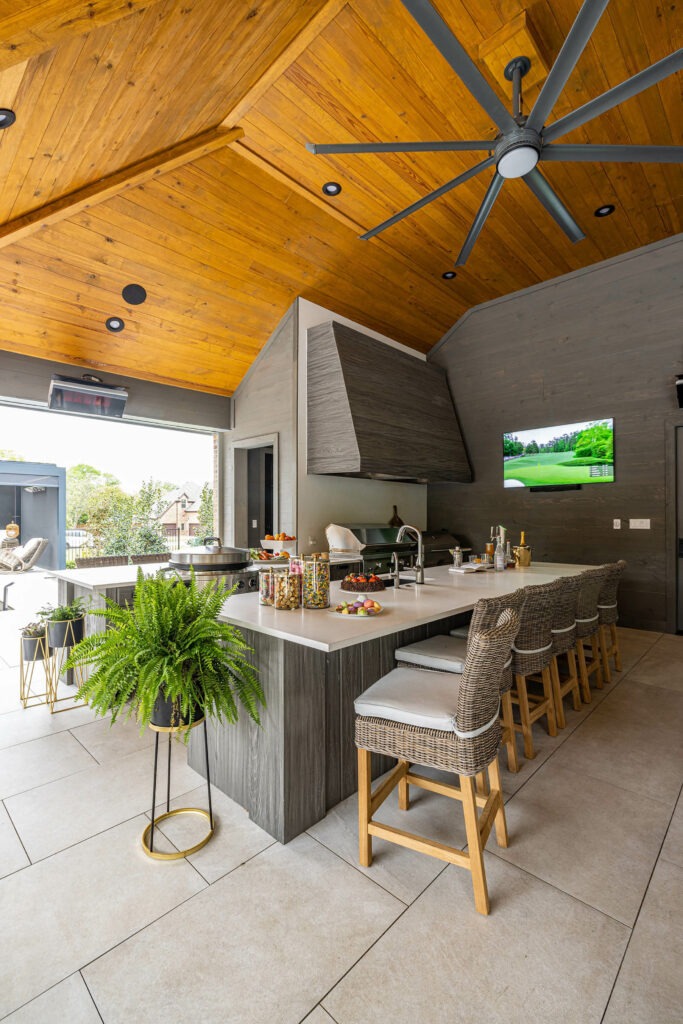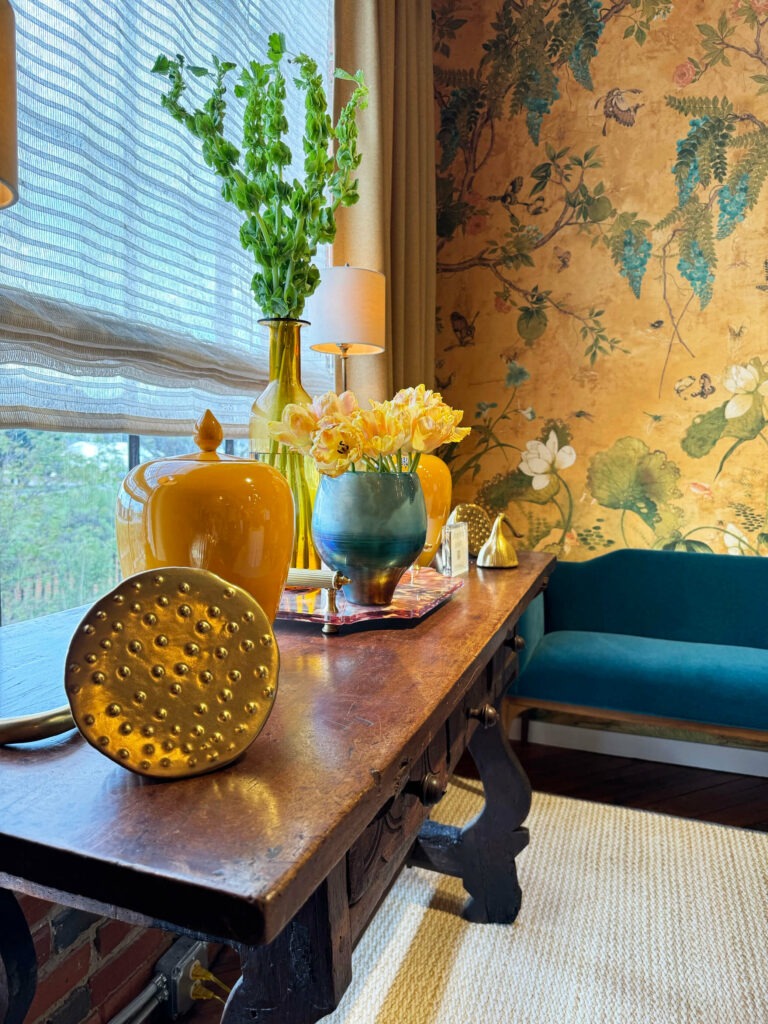The thought of “bringing the outdoors in” has been a hot one for years. And now, as winter grows closer and daylight fades earlier every day, our connection to nature is at risk of getting LOST in the cold months.
Bringing the outdoors in plays a powerful role in winter that most of us completely forget. Spring and summer invite thoughts of lush greenery and biophilic design. It’s even more important, however, to tap the benefits of these luscious design trends in winter!!
READ: This is how you create spaces that promote wellness along with comfort. It offers us emotional solace—especially when it’s dark and cold outside. This could reduce stress and enhance your loving your home in a HUGE way this year.
With fewer opportunities to be outside over the next few months, the following indoor-outdoor AND nature-inspired designs become crucial. Whether that means connecting your indoor spaces to the outdoors or refreshing your home with subtle natural elements, all of the ideas you need are right here…

See what’s possible in indoor-outdoor design…
One of the most exciting movementsin home design in the last 50 years is indoor-outdoor renovations. To capture just how exciting this really is, we have to think WAY past installing bigger windows or adding a patio.
Instead, today’s indoor-outdoor possibilities blur the lines between indoors and out…they create spaces where nature isn’t just seen, but felt. These are the environments where you HEAR the sounds of outdoors…you TOUCH natural elements…but you still enjoy the indoor comforts of climate control, for example.
Our award-winning indoor-outdoor pool cabana is a perfect example. The addition added a seamless transition between the main home, whose 15-foot doorway opens up to the back yard. There stands the pool cabana, a year-round entertainment space that can be totally open-air or turned into an oasis for entertainment during the winter.

Here are some more specific design ideas for turning your home into an indoor-outdoor paradise…
- Retractable glass walls: Removing barriers altogether can instantly create an indoor-outdoor experience.
- Outdoor kitchens and dining spaces: Extend your living areas with a fully functional outdoor kitchen, added adjacent to the indoor one.
- Indoor gardens or greenhouses: Transform a solarium or install an enclosed glass space to allow plants to thrive year-round.
- Indoor-outdoor pools: Pools can be designed to stretch from the inside of the home to the outside, giving you the best of both worlds.
- Patio extensions that mimic indoor comforts: Add cozy fireplaces and weatherproof furniture to create outdoor lounges for a true living space, regardless of the season.
Biophilic Design Merging Nature with Décor
It’s no coincidence that biophilic design has grown in popularity at the same time as indoor-outdoor living. And just in the last few years, several key design trends have actually set the stage for biophilic interiors to truly thrive…
- The focus on wellness in interior spaces
- The interest in eco-friendly design
- Increasing awareness of sustainability
Today, homeowners dream of spaces that aren’t just beautiful, but support the lifestyles they want to live. This means spaces have to boost both mental and physical wellbeing…and biophilic design offers a little of both.
By weaving natural materials, organic patterns, and nature-inspired elements into living spaces, we create environments that feed the soul.

Another Trend That’s Influenced Biophilic Design
At the same time that biophilic design has boomed, maximalist trends have moved in. The bold use of color and texture invites layers of organic patterns, plants, and natural materials.
Together, maximalism and biophilic design have become core principles of the most enriching and contemporary interiors.
Here are some specific ways that biophilic themes are being used in interior design…
- Natural materials: Incorporating wood, stone, bamboo, or cork into furniture and finishes for a tactile connection to nature.
- Organic shapes and patterns: Using furniture and decor that mimic natural forms, like curving lines and leaf-like motifs.
- Living walls: Vertical gardens or walls covered in plants create a lush, living element within the home.
- Indoor water features: The sound of flowing water to add tranquility or a sense of the natural world indoors.
- Maximizing natural light: Extra-large windows, skylights, and strategically placed mirrors to help brighten spaces and invite in more natural light.

How to Use Plants in Design
Plants—both real and “permanents,” as faux flowers and greenery are called—have been favorites in interior design for generations.
The reasons why these are so popular, though, go FAR beyond aesthetic appeal. Still…many homeowners don’t realize what additional benefits they stand to gain by using plants in design.
For instance, we all know that plants can improve air quality. We also know that both real plants and “permanents” add a touch of beauty. What we don’t always realize is that they also contribute to a calming and relaxing environment. Plants also serve as natural noise dampeners, which makes rooms feel more serene—no longer just by touch and look, but by auditory feedback, too! They also reduce the dryness of air, ESPECIALLY during winter months when heaters are on.
The presence of greenery has more recently been shown to boost creativity and focus, making them an even more popular addition since home offices have become the new norm.

Here are some specific ideas for incorporating plants (real or “permanents”) into design…
- Large statement plants: Use tall indoor plants like fiddle-leaf figs to anchor corners and bring in especially lush greenery.
- Hanging plants: Add wall-mounted planters or hanging pots to add greenery without taking up floor space.
- Herb gardens: Small herb pots or wall-mounted planters in or near the kitchen add functionality and charm.
- Plant clusters: Group plants of different sizes together to create a natural, layered effect that goes perfectly with today’s maximalist trends.
- Shelf decor: Add smaller plants like succulents to bookshelves, mantels or side tables for a soft and organic touch.
Real vs. “Permanent” Plants: What’s right for you?
Real plants provide all the air-purifying and wellness benefits, but they require care and ideal lighting. Permanents, on the other hand, offer the beauty of real plants without the need for watering or sunlight.
Real plants:
- Improve air quality
- Provide natural scents
- Offer emotional benefits of nurturing a living thing
Permanents:
- Zero maintenance required
- Perfect for low-light areas
- Always look pristine with no risk of wilting or discoloration
To decide which is best for your design, ask yourself:
- Do you enjoy taking care of plants?
- Do you have the time to water and maintain them?
- Do your living spaces get enough natural light?
If you answered yes to two or more questions, real plants are probably the best fit for you. If not, permanents can still bring the beauty of nature into your home without extra work!!
The benefits of bringing the outdoors in are even MORE important in winter months, and there are plenty of ideas above that you could consider doing right away in your home.
What indoor-outdoor or biophilic design would YOU like to try?! Inquire with us for anything that needs interior design or design-build renovation experience…we would love to help!!
About the author

Robin Burrill, RID, NCIDQ, ASID, IDS, CAPS, is an award-winning professional kitchen, bath, and interior designer. Robin and her husband, Robert Mathews, have owned Signature Home Services, Inc. for nearly three decades, establishing a superior in-house team with a widespread reputation for delivering meticulous design to their many repeat clients.
In 2022, the national publication, Kitchen and Bath Design News magazine, named Robin to their Top Innovator list in recognition of her achievements in the field of kitchen and bath design. In 2024, she was named one of the Fall 2024 Market Pros and “tastemakers” by ANDMORE at High Point Market. Also in 2024, Fixr identified her as one of the Top Professional Interior Designers for their nationwide audience. Over her extensive career, Robin has been quoted in Architectural Digest and Forbes multiple times; her design work has been featured in top national trade publications; and she has been interviewed for Designers Today magazine’s “Profiles in Design” video series, among others. Widely respected for the depth of her knowledge, Robin is a sought after speaker and judge for many design industry events.
In 2023, Robin designed a bench for Charleston Forge, making her foray into product design. Robin currently serves as a volunteer on the board of the Dallas/Ft. Worth chapter of the Interior Design Society.


Leave a Reply